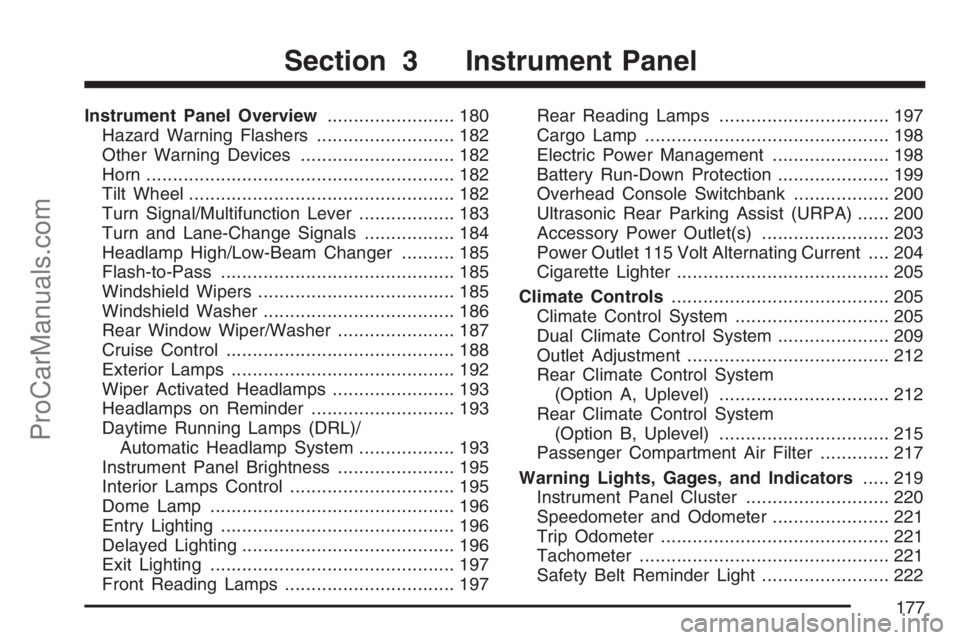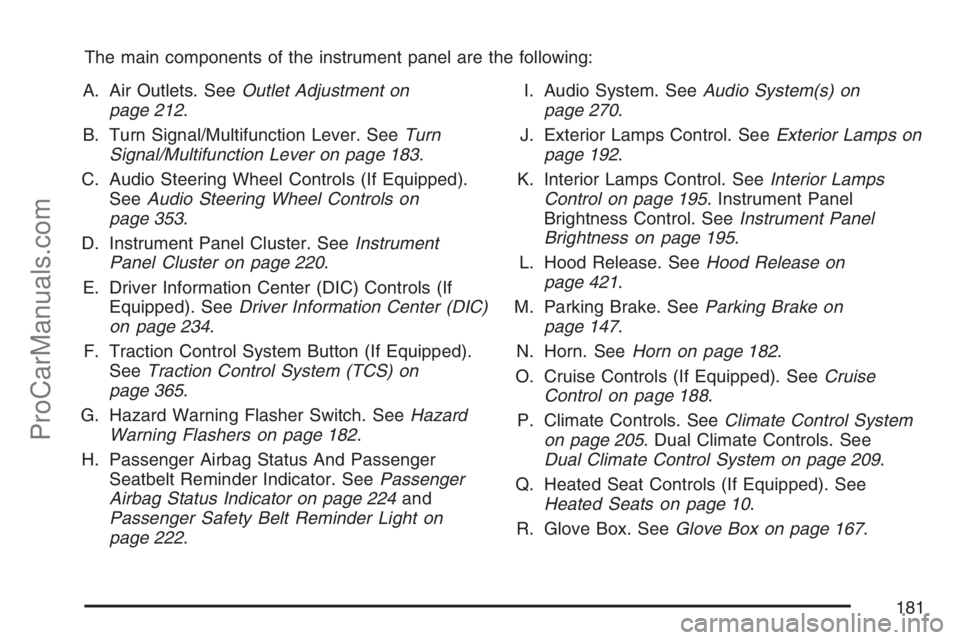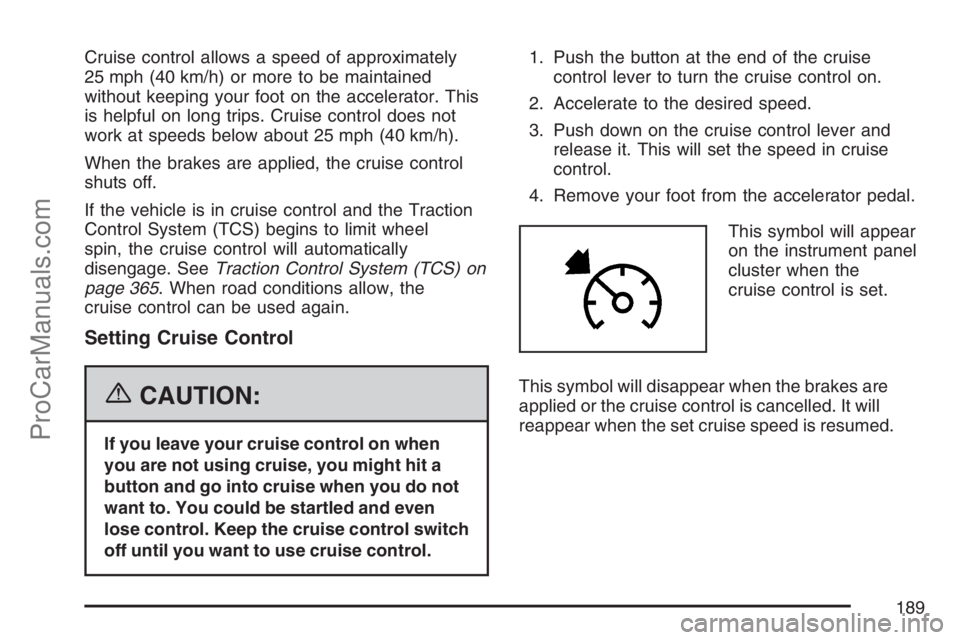instrument cluster SATURN RELAY 2007 Owners Manual
[x] Cancel search | Manufacturer: SATURN, Model Year: 2007, Model line: RELAY, Model: SATURN RELAY 2007Pages: 570, PDF Size: 3.41 MB
Page 86 of 570

There is an airbag
readiness light on the
instrument panel cluster,
which shows the
airbag symbol.
The system checks the airbag electrical system for
malfunctions. The light tells you if there is an
electrical problem. SeeAirbag Readiness Light on
page 223for more information.Where Are the Airbags?
The driver’s frontal airbag is in the middle of the
steering wheel.
86
ProCarManuals.com
Page 98 of 570

{CAUTION:
If the airbag readiness light in the
instrument panel cluster ever comes on
and stays on, it means that something
may be wrong with the airbag system. If
this ever happens, have the vehicle
serviced promptly, because an adult-size
person sitting in the right front
passenger’s seat may not have the
protection of the frontal airbag. See
Airbag Readiness Light on page 223for
more on this, including important safety
information.Aftermarket equipment, such as seat covers, can
affect how well the passenger sensing system
operates. You may want to consider not using seat
covers or other aftermarket equipment if your
vehicle has the passenger sensing system. See
Adding Equipment to Your Airbag-Equipped
Vehicle on page 100for more information about
modi�cations that can affect how the system
operates.
{CAUTION:
Stowing of articles under the passenger’s
seat or between the passenger’s seat
cushion and seatback may interfere with
the proper operation of the passenger
sensing system.
98
ProCarManuals.com
Page 177 of 570

Instrument Panel Overview........................ 180
Hazard Warning Flashers.......................... 182
Other Warning Devices............................. 182
Horn.......................................................... 182
Tilt Wheel.................................................. 182
Turn Signal/Multifunction Lever.................. 183
Turn and Lane-Change Signals................. 184
Headlamp High/Low-Beam Changer.......... 185
Flash-to-Pass............................................ 185
Windshield Wipers..................................... 185
Windshield Washer.................................... 186
Rear Window Wiper/Washer...................... 187
Cruise Control........................................... 188
Exterior Lamps.......................................... 192
Wiper Activated Headlamps....................... 193
Headlamps on Reminder........................... 193
Daytime Running Lamps (DRL)/
Automatic Headlamp System.................. 193
Instrument Panel Brightness...................... 195
Interior Lamps Control............................... 195
Dome Lamp.............................................. 196
Entry Lighting............................................ 196
Delayed Lighting........................................ 196
Exit Lighting.............................................. 197
Front Reading Lamps................................ 197Rear Reading Lamps................................ 197
Cargo Lamp.............................................. 198
Electric Power Management...................... 198
Battery Run-Down Protection..................... 199
Overhead Console Switchbank.................. 200
Ultrasonic Rear Parking Assist (URPA)...... 200
Accessory Power Outlet(s)........................ 203
Power Outlet 115 Volt Alternating Current.... 204
Cigarette Lighter........................................ 205
Climate Controls......................................... 205
Climate Control System............................. 205
Dual Climate Control System..................... 209
Outlet Adjustment...................................... 212
Rear Climate Control System
(Option A, Uplevel)................................ 212
Rear Climate Control System
(Option B, Uplevel)................................ 215
Passenger Compartment Air Filter............. 217
Warning Lights, Gages, and Indicators..... 219
Instrument Panel Cluster........................... 220
Speedometer and Odometer...................... 221
Trip Odometer........................................... 221
Tachometer............................................... 221
Safety Belt Reminder Light........................ 222
Section 3 Instrument Panel
177
ProCarManuals.com
Page 181 of 570

The main components of the instrument panel are the following:
A. Air Outlets. SeeOutlet Adjustment on
page 212.
B. Turn Signal/Multifunction Lever. SeeTurn
Signal/Multifunction Lever on page 183.
C. Audio Steering Wheel Controls (If Equipped).
SeeAudio Steering Wheel Controls on
page 353.
D. Instrument Panel Cluster. SeeInstrument
Panel Cluster on page 220.
E. Driver Information Center (DIC) Controls (If
Equipped). SeeDriver Information Center (DIC)
on page 234.
F. Traction Control System Button (If Equipped).
SeeTraction Control System (TCS) on
page 365.
G. Hazard Warning Flasher Switch. SeeHazard
Warning Flashers on page 182.
H. Passenger Airbag Status And Passenger
Seatbelt Reminder Indicator. SeePassenger
Airbag Status Indicator on page 224and
Passenger Safety Belt Reminder Light on
page 222.I. Audio System. SeeAudio System(s) on
page 270.
J. Exterior Lamps Control. SeeExterior Lamps on
page 192.
K. Interior Lamps Control. SeeInterior Lamps
Control on page 195. Instrument Panel
Brightness Control. SeeInstrument Panel
Brightness on page 195.
L. Hood Release. SeeHood Release on
page 421.
M. Parking Brake. SeeParking Brake on
page 147.
N. Horn. SeeHorn on page 182.
O. Cruise Controls (If Equipped). SeeCruise
Control on page 188.
P. Climate Controls. SeeClimate Control System
on page 205. Dual Climate Controls. See
Dual Climate Control System on page 209.
Q. Heated Seat Controls (If Equipped). See
Heated Seats on page 10.
R. Glove Box. SeeGlove Box on page 167.
181
ProCarManuals.com
Page 184 of 570

LWindshield Washer. SeeWindshield
Washer on page 186.
ZRear Window Wiper. SeeWindshield
Washer on page 186.
=Rear Window Washer. SeeWindshield
Washer on page 186.
For information on the headlamps, seeExterior
Lamps on page 192.
Turn and Lane-Change Signals
The turn signal has two upward (for right) and
two downward (for left) positions. These positions
allow you to signal a turn or a lane change.
To signal a turn, move the lever all the way up or
down. When the turn is �nished, the lever will
return automatically.
An arrow on the
instrument panel cluster
will �ash in the direction
of the turn or lane
change.To signal a lane change, just raise or lower the
lever until the arrow starts to �ash. Hold it
there until you complete your lane change. The
lever will return by itself when you release it.
As you signal a turn or a lane change, if the arrow
�ashes faster than normal, a signal bulb may
be burned out and other drivers will not see your
turn signal.
If a bulb is burned out, replace it to help avoid an
accident. If the arrows do not go on at all when
you signal a turn, check for burned-out bulbs and
check the fuse. SeeBulb Replacement on
page 455andFuses and Circuit Breakers on
page 512.
If you have a trailer towing option with added
wiring for the trailer lamps, the signal indicator will
�ash at a normal rate even if a turn signal bulb
is burned out. Check the front and rear turn signal
lamps regularly to make sure they are working.
184
ProCarManuals.com
Page 185 of 570

Turn Signal On Chime
If either turn signal is left on for more than 3/4 mile
(1.2 km), a chime will sound to let the driver
know to turn it off. If you need to leave the signal
on for more than 3/4 mile (1.2 km), turn off the
signal and then turn it back on.
Headlamp High/Low-Beam Changer
To change the headlamps from low beam to
high beam, push the turn signal/multifunction lever
away from you.
When the high beams
are on, this light will
appear on the
instrument panel cluster.
To change the headlamps from high beam to low
beam, pull the turn signal/multifunction lever
toward you.
Flash-to-Pass
When the headlamps are off, pull the lever toward
you to momentarily turn on the high beams.
This will signal that you are going to pass. When
you release the lever, they will turn off.
Windshield Wipers
You control the windshield wipers by turning the
band with the wiper symbol on it.
8(Mist):For a single wiping cycle, turn the
band to mist. Hold it there until the wipers start.
Then let go. The wipers will stop after one wipe.
If you want more wipes, hold the band on mist
longer.
9(Off):To stop the wipers, move the band to off.
N(Delay):You can set the wiper speed for a
long or short delay between wipes. This can
be very useful in light rain or snow. Turn the band
to choose the delay time. The closer to the top
of the lever, the shorter the delay.
185
ProCarManuals.com
Page 189 of 570

Cruise control allows a speed of approximately
25 mph (40 km/h) or more to be maintained
without keeping your foot on the accelerator. This
is helpful on long trips. Cruise control does not
work at speeds below about 25 mph (40 km/h).
When the brakes are applied, the cruise control
shuts off.
If the vehicle is in cruise control and the Traction
Control System (TCS) begins to limit wheel
spin, the cruise control will automatically
disengage. SeeTraction Control System (TCS) on
page 365. When road conditions allow, the
cruise control can be used again.
Setting Cruise Control
{CAUTION:
If you leave your cruise control on when
you are not using cruise, you might hit a
button and go into cruise when you do not
want to. You could be startled and even
lose control. Keep the cruise control switch
off until you want to use cruise control.1. Push the button at the end of the cruise
control lever to turn the cruise control on.
2. Accelerate to the desired speed.
3. Push down on the cruise control lever and
release it. This will set the speed in cruise
control.
4. Remove your foot from the accelerator pedal.
This symbol will appear
on the instrument panel
cluster when the
cruise control is set.
This symbol will disappear when the brakes are
applied or the cruise control is cancelled. It will
reappear when the set cruise speed is resumed.
189
ProCarManuals.com
Page 194 of 570

A light sensor on top of the instrument panel
makes the DRL work, so be sure it is not covered.
The DRL system will make front parking and
turn signal lamps come on in daylight when the
following conditions are met:
The ignition is on.
The exterior lamps control is off.
When the DRL are on, only your front turn signal
lamps will be on. Your instrument panel will
not be lit up.
When it is dark enough outside, the exterior lamps
will come on automatically. When it is bright
enough outside, the exterior lamps will turn off and
the DRL will turn on. Of course, you may still
turn on the headlamps any time you need to.If you start your vehicle in a dark garage, the
automatic headlamp system will come on
immediately. Once you leave the garage, it will
take approximately 30 seconds for the automatic
headlamp system to change to DRL if it is
light outside. During that delay, your instrument
panel cluster may not be as bright as usual. Make
sure your instrument panel brightness control is
in the full bright position. SeeInstrument
Panel Brightness on page 195.
To idle your vehicle with the DRL and automatic
headlamps off, toggle the exterior lamp control
to off after starting the vehicle.
As with any vehicle, you should turn on the
regular headlamp system when you need it.
194
ProCarManuals.com
Page 220 of 570

Instrument Panel Cluster
Your instrument panel cluster is designed to let you know at a glance how your vehicle is running. You will
know how fast you are going, how much fuel you are using, and many other things you will need to drive
safely and economically. The indicator warning lights and gages are explained on the following pages.
United States version shown, Canada similar
220
ProCarManuals.com
Page 234 of 570

Here are four things some owners ask about.
All these things are normal and do not indicate that
anything is wrong with the fuel gage.
At the gas station, the gas pump shuts off
before the gage reads full.
It takes a little more (or less) fuel to �ll up
than the gage reads. For example, the
gage read half full, but it took more (or less)
than half of the tank’s capacity to �ll it.
The gage pointer may move while cornering,
braking or speeding up.
The gage may not indicate empty when the
ignition is turned off.
Low Fuel Warning Light
The light next to the fuel gage will come on brie�y
when you are starting the engine.
This light comes on when the fuel tank is low on
fuel. To turn it off, add fuel to the fuel tank.
Driver Information Center (DIC)
Your vehicle has a Driver Information Center (DIC).
All messages will appear in the DIC display
located in the instrument panel cluster, below the
tachometer. The DIC buttons are located on
the center of the instrument panel, below the
center outlets.
The DIC comes on when the ignition is on. After a
short delay, the DIC will display WELCOME
DRIVER (1 or 2) if a personalized key 1 or 2 is
used, and then the information that was last
displayed before the engine was turned off. The
driver number also corresponds to the numbers,
1 or 2, on the back of the remote keyless entry
transmitters.
The DIC displays the odometer, trip odometers,
fuel economy, trip computer, vehicle system
information, and compass display, if equipped.
It also displays warning messages if a system
problem is detected. In addition, the DIC displays
phone numbers that are called using the
OnStar
®system, if equipped. SeeOnStar®
System on page 154.
234
ProCarManuals.com